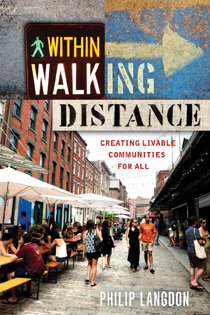Please read and report your takeaway
Human scale and Human action are A Priori.

For five thousand years, human settlements were nearly always compact places. Everything a person needed on a regular basis lay within walking distance. But then the great project of the twentieth century—sorting people, businesses, and activities into separate zones, scattered across vast metropolises—took hold, exacting its toll on human health, natural resources, and the climate. Living where things were beyond walking distance ultimately became, for many people, a recipe for frustration. As a result, many Americans have begun seeking compact, walkable communities or looking for ways to make their current neighborhood better connected, more self-sufficient, and more pleasurable.In Within Walking Distance, journalist and urban critic Philip Langdon looks at why and how Americans are shifting toward a more human-scale way of building and living. He shows how people are creating, improving, and caring for walkable communities. There is no one-size-fits-all approach. Starting conditions differ radically, as do the attitudes and interests of residents. To draw the most important lessons, Langdon spent time in six communities that differ in size, history, wealth, diversity, and education, yet share crucial traits: compactness, a mix of uses and activities, and human scale. The six are Center City Philadelphia; the East Rock section of New Haven, Connecticut; Brattleboro, Vermont; the Little Village section of Chicago; the Pearl District in Portland, Oregon; and the Cotton District in Starkville, Mississippi. In these communities, Langdon examines safe, comfortable streets; sociable sidewalks; how buildings connect to the public realm; bicycling; public transportation; and incorporation of nature and parks into city or town life. In all these varied settings, he pays special attention to a vital ingredient: local commitment.
To improve conditions and opportunities for everyone, Langdon argues that places where the best of life is within walking distance ought to be at the core of our thinking. This book is for anyone who wants to understand what can be done to build, rebuild, or improve a community while retaining the things that make it distinctive.
"Hard to put down...the book is so rich in detail that I learned something useful or remarkable on nearly every page. Langdon is one of the most experienced and knowledgeable writers on urbanism today...The new urban era is upon us and Within Walking Distance may be the best guidebook to explore how people and places are making this period a reality." Public Square"Talks convincingly about changes our cities and neighborhoods are going through...The stories are important, because they help us see that nothing is predetermined."
Common Edge"Within Walking Distance shines...a warm, personal, and heartening depiction of our power to shape our communities in a positive way when we set our minds to it."
Civil Engineering"Provocative...Langdon helps to unravel the mystery [of walkability]."
Governing"Intriguing...[Langdon] is a clear and insightful writer, has been exploring these topics for decades, and knows of what he speaks."
Connecticut Mirror"Makes the impassioned and convincing case that a place's walkability can serve as a catalyst for community."
Connecticut Magazine"Langdon examines the ingredients that create a safe, healthy, and vibrant community. While income levels may vary, community engagement, access to schools, transportation, healthcare, and retail strips are necessary factors for thriving neighborhoods. This work is a significant contribution to the literature on the diverse urban American tapestry. Langdon accurately conveys the struggles of neighborhoods seeking to remain a mainstay of this urbanism."
Jesús ?Chuy? García, Cook County Commissioner"With a Jane Jacobs-like eye for closely observing the workings of a neighborhood, Langdon explores why our experience of community life is so much richer in places that are laid out at a pedestrian scale. Through the stories of six communities, he shows the particular power that walkable neighborhoods have to inspire people to act for the common good. Along the way, Langdon examines how these neighborhoods came into being and the exciting things their residents are doing to improve them."
Stacy Mitchell, Codirector of the Institute for Local Self-Reliance and author of "Big-Box Swindle""In Within Walking Distance, Phil Langdon has given voice to the everyday people working to build vibrant, walkable places in their own communities. With rich storytelling backed by extensive research, he spotlights the incremental victories that are essential to creating places people love. Within Walking Distance is a human-scale book about human-scale solutions—for downtowns, neighborhoods, suburbs, and everywhere in between."
Lynn Richards, President and CEO, the Congress for the New Urbanism"Philip Langdon has pulled together his thirty years of experience and wisdom in a compelling book about the incremental, organic approach to walkable urban vitality. At many levels of intensity, from Center City Philadelphia to small Stakville, Mississippi, Langdon has provided case studies of how walkable vitality has been successfully created and, just as importantly, sometimes has fallen backward. In addition, noted New Urban architect Dhiru Thadani has contributed charming drawings knitting the book into an integrated whole."
Christopher B. Leinberger, Charles Bendit Distinguished Scholar and Research Professor of Urban Real Estate
[amazon_link asins='1610917715' template='ProductAd' store='flbikeped-20' marketplace='US' link_id='9044ee93-946e-11e8-b31d-7bb7b80937d5']
[amazon_link asins='B01M0P6RXS,B01M311ACN,B01HYRGUXW,B074KT43HR,B06WP555ND' template='ProductCarousel' store='flbikeped-20' marketplace='US' link_id='be1c2954-946e-11e8-9a04-bfd0b3182137']
Posted from my blog with SteemPress : https://flbikeped.com/2018/07/31/within-walking-distance-requesting-a-book-review/
Hi! I am a robot. I just upvoted you! I found similar content that readers might be interested in:
https://www.amazon.com/Within-Walking-Distance-Creating-Communities/dp/1610917715
Downvoting a post can decrease pending rewards and make it less visible. Common reasons:
Submit